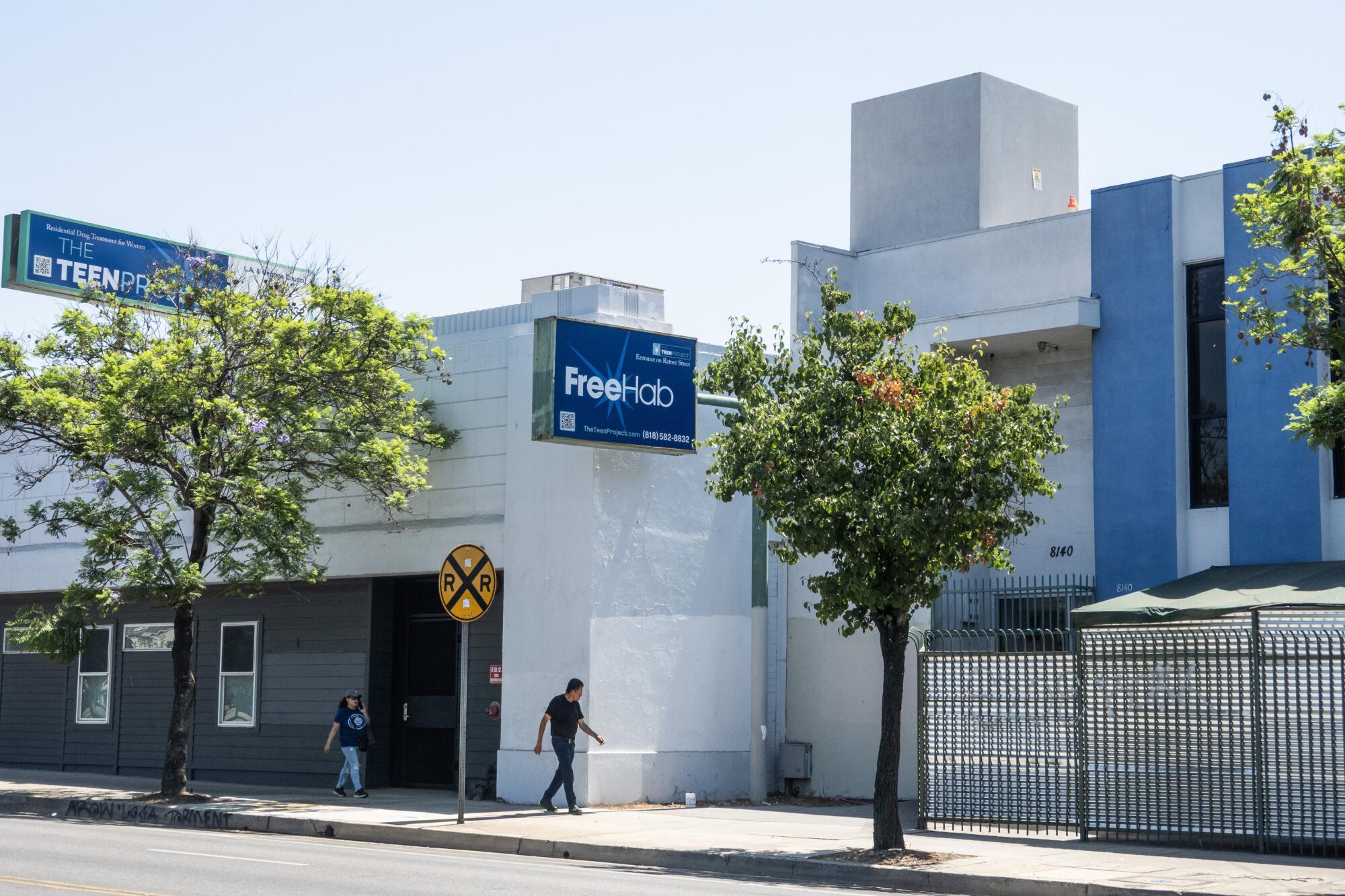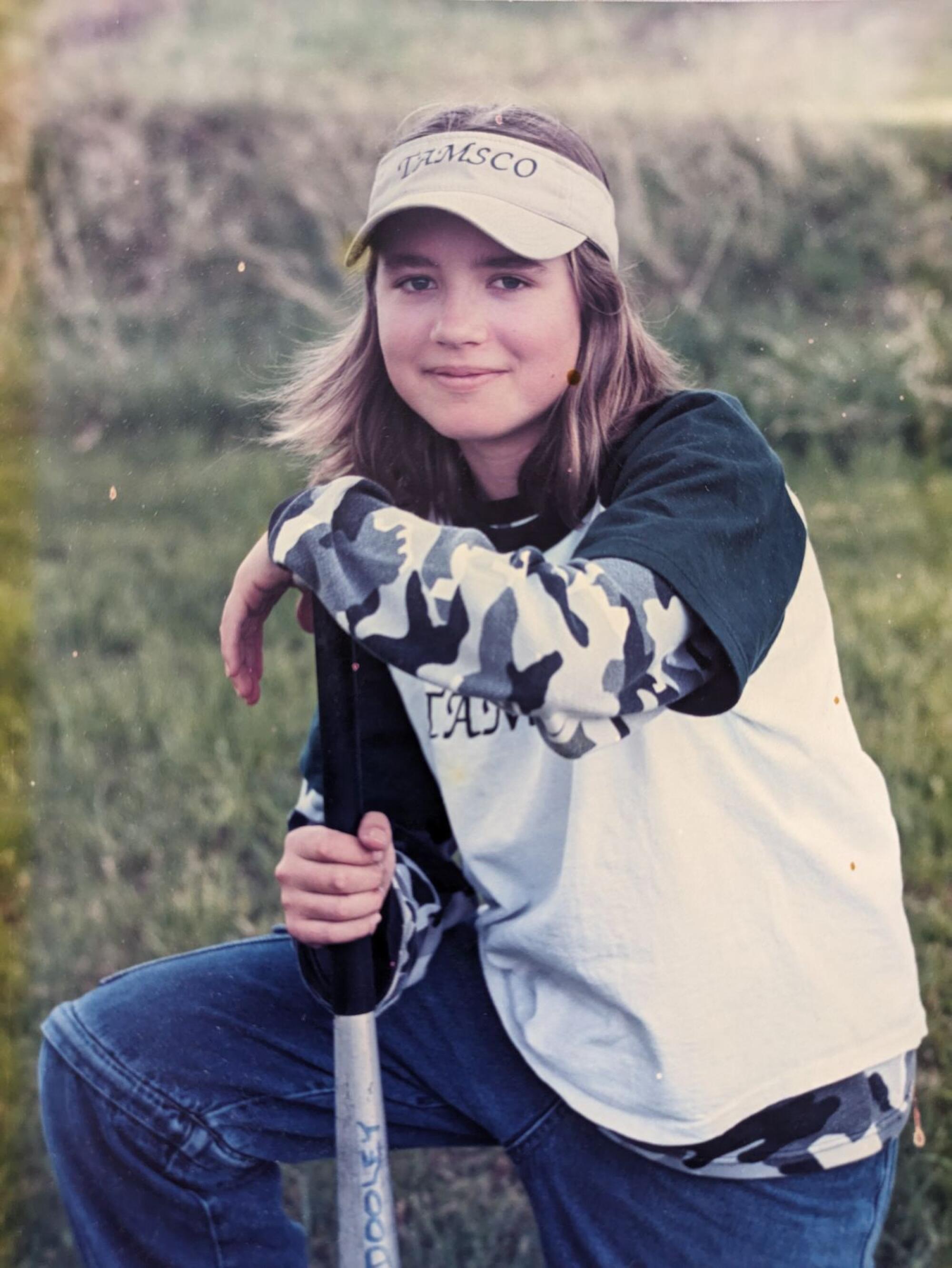
- Share via
Jasmine Richardson had been struggling with methamphetamine and fentanyl addiction for more than a decade, but she got sober after completing a six-month program at the Teen Project’s Freehab center on Sunland Boulevard in Sun Valley.
That was right around Thanksgiving last year, and it was the first time the 33-year-old had been clean in years. Still, she wasn’t ready to leave the Freehab just yet; homeless since 2020, she wanted to spend at least a year in the 74-bed rehab facility before finding temporary housing. Then she hoped to move her teenage son up to L.A. to live with her, and to pursue her dream of becoming a veterinarian tech.
All of that was cut short Dec. 4, when the Los Angeles Fire Department shut down the facility over what it said were building and fire code violations, officials said. The group of 43 women, whose ranks included survivors of human trafficking, substance abuse and homelessness, had a few hours to pack up their belongings and find a new place to stay.
Richardson’s mother, Janet Dooley, picked her up from Freehab and brought her back to Dooley’s home in Huntington Beach. Eight days later, Dooley found her daughter dead from an overdose of meth and fentanyl.

“I believe that if the place hadn’t closed,” Dooley said, “she’d still be alive today.”
More than six months after the closure, questions about why it was forced to shut down are at the forefront of a lawsuit filed by the Teen Project, the nonprofit that operated the Freehab, against A&E Development Co., the facility’s landlord. The nonprofit alleges that A&E breached its lease and failed to maintain conditions that adhered to building codes, regulations, permits and ordinances, resulting in the rehab’s shutdown.
The organization is seeking at least $5 million in damages.
On a GoFundMe page created to raise money for a new treatment facility, the Teen Project blamed its landlord’s “refusal to ensure building’s upkeep” and the Fire Department’s “unwillingness to compromise, and exerting their power, even if it cost our girls their lives.”
According to safety violation notices from the L.A. City Fire Department obtained by The Times, the Freehab had been ordered multiple times since at least September to get a fire permit to operate a residential care facility, hire fire watch personnel, install automatic fire sprinklers throughout the building and obtain a valid permit for the fire door connecting the Freehab and the adjacent building.
The organization was notified via both email and mailed letters addressed to the Sun Valley facility, according to the notices.
The alleged safety issues apparently go back even further. According to Fox 11, LAFD Assistant Fire Chief Kristine Larson told the Freehab’s staff in December: “In 2020, this building was required to have sprinklers, and it does not have sprinklers; therefore, it is unsafe to be occupied for overnight use.”
Lauri Burns, executive officer of the Teen Project, said via email that she found out about the alleged violations a week before the closure.
“They said they weren’t shutting us down and they would give us ample time to fix things, and then they returned one week later and shut us down without notice,” Burns added.
Burns said after learning about the violations, the Freehab complied with nearly all of the requirements and paid around $7,000 a week to have a fire watch on-site at all hours. She said they weren’t able to install sprinklers because that process would take at least a month and require permits and inspections.

In its Jan. 31 lawsuit, the Teen Project alleges that A&E failed to address rat and maggot infestations at the Freehab, ignored unauthorized trailers and homelessness in the Freehab’s shared parking lot and didn’t repay the Teen Project for replacing HVAC systems and other amenities.
Because of A&E’s “inability to provide a useable/safe space to lease for its intended purpose,” the lawsuit states, the Freehab was forced to shut down.
“The residents under The Teen Project’s care were traumatically displaced from their safety net, and horrifically resulted in the relapse and death of a young woman only a few days later,” according to the lawsuit.
In court papers, A&E disavowed responsibility for the shuttering of the Freehab, saying “the facts and the law are clear that the A&E is not responsible for ensuring the Premises could be used as a rehab facility.” A&E argued that the Teen Project “voluntarily vacated” the Freehab after the Fire Department and the California Department of Health Care Services revoked permits to operate the rehab facility.
After the Freehab’s shutdown, A&E said, it received a notice from the Teen Project demanding that A&E bring the Freehab up to code. But according to A&E, the lease required it to fix problems only if they were raised within six months of the start of the lease. The Teen Project terminated its lease on Jan. 19 after the conditions to operate the Freehab weren’t met.
The LAFD said in a Dec. 5 statement after the Freehab’s closure that the agency “will continue to provide guidance to the building owner and lessee regarding required compliance with the fire violations and change-of-use permits to ensure the safety and security of the tenants and the property.”
“The California Department of Health Care Services is responsible for ensuring this type of facility is in compliance with the fire code and questions regarding the status of this facility’s license to operate should be directed to them,” according to the statement. “They are also responsible for rehousing any displaced residents.”
LAFD spokesperson Karla Tovar said that a fire code change in 2020 required sprinklers in the type of building that housed the Freehab. The alleged violations were found during a fire inspection and “much research was done with many other agencies before the facility was closed,” she said.
In response to the Teen Project’s allegation that LAFD’s actions somehow contributed to the overdose death of one of the Freehab’s clients, Tovar said in an emailed statement:
“The LAFD is committed to preserving life, protecting property, and safeguarding our communities. Ensuring that buildings operate according to fire and life safety regulations is a matter we take seriously for residents, patrons, employees, and owners.”
A spokesperson from the California Department of Health Care Services confirmed that the Freehab was deemed noncompliant with the fire code. The agency said it was able to get 32 of the 43 women into other treatment centers across L.A. However, Richardson told them she wanted to go home to be with her son, her mother said.
The Teen Project, whose name was born out of “teenagers exiting foster care to homelessness and trafficking,” according to Burns, opened a new facility in June called the Van Nuys Sanctuary. At least 10 of the women who stayed at the Freehab reached out and asked if they could get a spot at the new center, according to Teen Project program director Melissa Coons.
“They have a safe place to be and we really try to make this place look like a home versus an institution,” she said. “We’re really excited to get back to helping the girls in the community.”
Richardson’s problems began in middle school, when she became depressed and started self-medicating with marijuana, Dooley said. It snowballed after she turned 18, when her father died and she later turned to meth. Richardson, her ex-boyfriend and her son lived with Dooley until well into the pandemic, when Dooley said she had to evict them.

“Things got worse and worse, and I had to get them out because I couldn’t live like that,” Dooley added.
After the Freehab closed, Richardson didn’t know what to do. According to her mother, she thought about going to a Narcotics Anonymous meeting. She texted employees from the Teen Project to see if she could get into temporary housing.
On Dec. 11, Dooley dropped Richardson off near the courthouse to handle a legal matter but didn’t hear from her for a few hours. Richardson came home late and said she had been with friends. Dooley got up for work around 3 a.m., and when she came home five hours later, she discovered that Richardson had overdosed.
“Jasmine was incredibly upset and scared” when the Freehab closed, Coons said. “Originally, she wanted to stay with us for a year, and she never really wavered from that.”
Tom Wolf, a recovering fentanyl and heroin addict who founded the Pacific Alliance for Prevention and Recovery, said that structure and routine are especially important in early recovery. Significant emotional events, such as a death in the family, job loss or a breakup can result in relapse.
“These folks were displaced, and even if they were offered shelter or housing in another program, they were displaced from friendships, the support systems and the structure of that specific program,” he said. “If you take all of those things away at once from someone after years of homelessness, it would be easy to go back onto the street and buy fentanyl for $5 and relapse.”
Yesenia Sanchez, 31, struggled with addiction to alcohol, but she has been sober for more than two years after completing the Freehab’s six-month program. She started out as an intern in the kitchen before becoming a full-time cook at the facility.
She wasn’t working the day the Freehab was forced to shut down, but once she heard about the closure, she scrambled to help the women find other places to stay. Some of them, she said, had to go back to living on the streets.
“That was really hard because those were the girls we were helping every day, and we just didn’t have enough time,” she said.
Casey Anderson, another former Freehab client, relapsed almost immediately after the facility closed down. Anderson first started abusing Ritalin as a teenager before getting addicted to meth. She was homeless for more than a year and slept in various parks in Lancaster before deciding she needed to get help.

Anderson started living at the Freehab in June 2023 and was two weeks away from completing her program when the facility closed.
“It was heartbreaking,” she said. “We all felt safe. We all felt like we had a place to go and then all of a sudden, it was taken from us.”
Anderson didn’t think she would need to go into another program after the Freehab’s closure. Instead, she reverted to living with her parents in Lancaster and quickly got hooked on drugs again. In early April, she contacted one of the program directors from the Teen Project to get on the waiting list for the new Van Nuys facility, where she moved June 6. There were eight women in the program as of June 25.
She is sober again and is hoping to get back to pursuing her dream of becoming a preschool teacher. In the meantime, she recently got a job working as a registered alcohol and drug technician.
“I thought I was ready to leave, but I wasn’t,” Anderson said. “I only had two weeks left, but it turns out I actually needed more. I probably would’ve known that if we had more time to work on it.”
More to Read
Sign up for Essential California
The most important California stories and recommendations in your inbox every morning.
You may occasionally receive promotional content from the Los Angeles Times.











